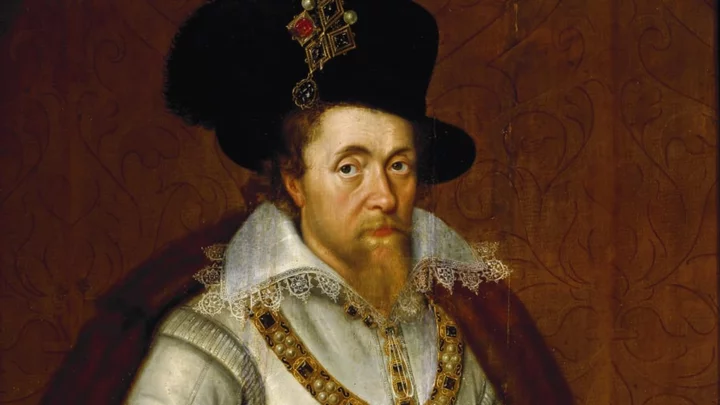James Charles Stuart became King of Scotland on July 24, 1567, at the age of 13 months, after his mother, Mary Queen of Scots, was forced to abdicate. Thus began the tenure of the fourth longest reigning British monarch, a king for 57 years whose longevity was not matched by fondness of public opinion.
On one hand, James VI and I’s reign was characterized by pragmatism (advocating for a single Parliament, attempting to achieve religious harmony), peace (brokering a treaty with Spain, among other things), and unity (of the Scottish and English crowns). On the other, he was authoritarian (believing in the divine right of kings), extravagant (prone to overspending the public purse), and terribly cruel (responsible for the deaths of thousands through state-sanctioned witch hunts). These monarchical facets changed society in ways that still reverberate today.
1. James VI and I united the “auld enemies” of England and Scotland …
The Romans’ failure to conquer the Caledonian tribes led to the building of Hadrian’s Wall. This may have kept the people north of the border out, but it didn’t stop William of Normandy (a.k.a. William I, “the Conqueror”) from invading Scotland in 1072, resulting in a truce. Peace didn’t last long, with subsequent battles such as Falkirk (1298) and Flodden (1513) bloodily carving their way through the centuries.
It’s therefore unsurprising that while peace may have been desired by the time James took the English throne, it was not straightforward. The English rejected political incorporation with Scotland, while Scotland favored a federative union. James VI and I’s uniting of the Crowns was significant, but it was more figurative than literal. He declared himself “King of Great Britain” in 1604, though in his lifetime the union was confined largely to symbolic reforms (such as the creation of the Union Jack). Its significance lay in paving the way for the political union 103 years later.
2. … but sowed the seeds for the English Civil War.
Despite James VI and I’s somewhat noble (and clearly personal) intentions in uniting the Crowns, there’s evidence this created religious and political tensions that led to the 17th century English Civil Wars and the decapitation of his son and heir, Charles I.
James VI and I’s uniting of the crowns left a vacuum in place of Scotland’s national figurehead. The National Library of Scotland states, “the removal of the Scottish king from his country was a major cause of the 17th-century civil wars ... James’s union gave England a royal family it distrusted and left Scotland without the key symbol of national independence.” After moving south to claim the English throne, James VI and I only returned to Scotland once, becoming increasingly out of touch with the country of his birth. Moreover, the Scots were not fond of the shared king they inherited in Charles I. Like his father, Charles did not like ruling over two different religious structures. When he tried to force his own prayer books on the Kirk (Church of Scotland), it led to riots throughout Edinburgh, contributing to mounting tensions between the nations that would eventually conflagrate into war.
James VI and I had styled himself as a “peacemaker,” but the hope for increased religious tolerance during his reign did not materialize. While the peace he brokered with Spain brought an end to 15 years of expensive wars and enmity, it disappointed Protestants who accused James VI and I (a Protestant himself) of submitting to “popery.” On the other hand, Catholics hoped James VI and I—whose mother, Mary Queen of Scots, and wife, Anne of Denmark, were both Catholic—would permit them to openly worship. But James VI and I lost sympathy for their cause after facing down numerous Catholic plots against him.
James VI and I also experienced several political breakdowns with Parliament that foreshadowed Charles I’s interactions. James VI and I was a believer in absolutism and the Divine Right of Kings, something he defined in The True Law of Free Monarchies as the monarch not being subject to any earthly authority. He flaunted lavish personal spending that his Secretary of State, Robert Cecil, sought to control. Charles I inherited his father’s absolutism and disdain for Parliament, dissolving it for years at a time unless it was in his own interests, factors that directly led to the Civil War and his own execution.
3. James VI and I ushered in peace by ending the Anglo-Spanish wars …
The latter part of Elizabeth I’s reign had been marked by conflict with Spain. Despite the English’s success over the Armada, ongoing Anglo-Spanish conflicts between Elizabeth I and Philip II meant that at the time of Elizabeth’s death, England had accrued large debts and the government was nearly bankrupt. When James VI and I ascended the English throne five years after Phillip II’s death, both he and Phillip III were keen for peace. They signed the Treaty of London at Somerset House in 1604, ushering in 50 years of stability between the old foes.
4. … but diminished the prosperity of merchants and privateers.
While James VI and I’s peace with Spain was celebrated in some quarters, others found it less favorable. The wars had been beneficial for some merchants, who became wealthy through privateering with Portuguese and Spanish ships in the southern Atlantic. In Elizabethan Privateering, K. R. Andrews describes how the activity was the “main form of English maritime warfare” at the time, and was “closely connected with trade.” Elizabeth I granted privateers—or Sea Dogs—such as Sir Francis Drake and Sir Walter Raleigh licenses to attack Spanish ships. The wealth the merchants backing the privateers accrued was a boost for England’s prosperity. As one historian noted, “the Elizabethan war with Spain … [reorientated] the English economy to the global stage.”
5. James VI and I was responsible for the torture and death of thousands accused of witchcraft.
The Scottish Witchcraft Act of 1563 had made capital offenses of practicing witchcraft and consulting with witches, but the fervor associated with the witch hunts didn’t start until long after James VI and I came to the throne. As Allan Kennedy writes in The Trial of Isobel Duff for Witchcraft, Inverness, 1662, “[witchcraft] prosecutions were rare until the 1590s, when the first ‘panics’ took place.”
Some wild weather is partially at fault. While sailing back to Scotland after their wedding, James and Anne passed through severe storms that nearly wrecked them. The blame was placed on witches, with some women confessing under torture that they had used witchcraft on the royals’ ship.
The wholesale persecution of those suspected of witchcraft began, starting with the North Berwick witch trials of 1590–1591. The exact number is not known, but it’s believed between 70 and 200 people were accused of witchcraft during that period, with many tortured and/or executed.
Further Scottish witch hunts occurred during intermittent “panics,” and by the time Janet Horne—the last person to be executed for witchcraft in Scotland—died in 1727, it’s estimated that up to 6000 people (85 percent of whom were women and mainly poor) had been accused of the “crime,” with up to 4000 put to death. This doesn’t include the 1000 or so estimated to have been killed in England and Wales; after James took the English throne, the English Parliament passed an Act “against Conjuration, Witchcraft and dealing with evil and wicked Spirits.”
In 2022, Nicola Sturgeon, former First Minister of Scotland, issued a formal apology for the “egregious historical injustice” of the witch hunts, commenting that “the deep misogyny that motivated it has not [been consigned to history]. We live with that still.”
6. James VI and I’s persecution of witches directly influenced literature.
James VI and I published his best-selling compendium, Daemonologie, in 1597. His treatise on proving the existence of witches helped drive the witch hunts, stating that extracting confessions by any means was justified on religious grounds.
It’s no coincidence that Macbeth was written at the start of James VI and I’s reign of England. According to the British Library, “Many elements of the witchcraft scenes in Macbeth conform to James VI and I’s ideas and beliefs in witchcraft as expressed in Daemonologie,” in addition to some of his other publications. That the witches in Macbeth dance, make potions, and keep familiars is in line with James VI and I’s published beliefs.
In Act 1, Scene 3, Shakespeare goes a step further. In apparent direct reference to the supposed actions of those tried at North Berwick, the first witch, in retaliation for a slight, talks of traveling out to sea in a sieve (small boat). The witches also conjure a storm.
While the focus on witches and witchcraft in Macbeth was likely borne from society’s beliefs at that time (which in no small part had been stoked by James VI and I and the likes of his Daemonologie), there is debate over whether Shakespeare was trying to curry favor with his king, or whether, as the British Library puts it, it was “a more subversive comment on [James’s] involvement with witch-hunting, or perhaps a mix of the two.”
Another classic likely influenced by the toxic societal brew James VI and I had stewed was Christopher Marlowe’s Doctor Faustus, first performed in 1594. Faustus has parallels with James VI and I, rejecting his studies of theology, medicine, and metaphysics in favor of the “metaphysics of magicians.” Looking beyond simplistic comparisons, many of Marlowe’s works explored what it was to be beyond the bounds of ordinary life.
As with Macbeth, Doctor Faustus may be more than the product of a playwright eager to please his king. As one scholar has noted, “James VI intended his Daemonologie to be a serious contribution to occult philosophy. Similarly Faustus can be seen not as a qualified occult philosopher but as a bumbling amateur. He is a man driven by his intellectual aspirations, but without the required rigorous application he falls subject to his own fantasies. The finger is pointed … at the soon to be king of England.”
7. James VI and I’s commissioned translation of the Bible influences literature to the present day.
The King James Bible, or the King James Version (KJV), represents another example of James VI and I’s wish to unify his kingdom under a single king and church. The advent of printing presses had led to an explosion in versions of the Bible in the 15th century. This caused consternation between various factions, not least with the Anglican bishops whose authority was challenged by the Geneva Bible, one of the most popular versions at the time of James VI and I’s accession.
In 1604, James VI and I took it upon himself to unite his subjects with one universally accepted text that would remove the problematic parts of some versions while remaining true to the style. It was a pragmatic solution to the religious tensions of the day, although not one without personal aim: By commissioning the translation, James VI and I sought to assert his authority over religious matters and solidify his reputation as a good king in one fell swoop.
Published in 1611, the KJV represented a democratized Bible, with teachings directly accessible to the people in a language they could understand for the first time. It spread rapidly throughout Europe and became the most widely-read version in countries where English was the first language.
Unfortunately for James VI and I, his translation made accessible to people passages not usually quoted in church. These made it clear that monarchs, too, are subject to the laws of God—a direct contradiction to James VI and I’s belief in the divine right. While this didn’t impact the king directly, as he died before the KJV became popular, it may have affected his son. Charles I’s belief in the divine right was a factor in the Civil War—a belief that was clearly undermined by his father’s bible.
Today, 412 years after it was published, the KJV is still the most popular version of the Bible, and one of the most printed books ever. The book is recognized for its literary quality; its influence is found in works from John Milton to Robert Burns to John Steinbeck. It is considered one of the most significant texts of all time, contributing 257 phrases to contemporary English idiom, including “a wolf in sheep’s clothing” and “by the skin of your teeth.”
This article was originally published on www.mentalfloss.com as From the Pragmatic to the Cruel: 7 Ways King James VI and I Changed Society.









